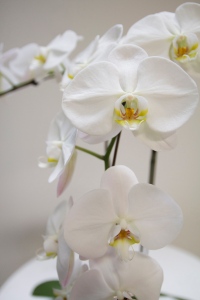Perhaps you’ve received an Orchid arrangement as a gift or you bought one on sale at a grocery and it was beautiful for a while, but now the flowers have all fallen off and you are left with a bald Orchid and the burning question: What do I do now?
If you’ve ever wondered if it was possible to get the Orchid to bloom again, you’ll be happy to know that it is not only possible but could even be considered … easy!
Despite their reputation for fussiness, the varieties of orchids most commonly used in arrangements, Phalaenopsis, Dendrobium, and Oncidium, can all rebloom if you take these few things into consideration:
- Location, Location, Location – Yes, as they say, it is everything. An ideal spot for an Orchid to rebloom is somewhere indoors with bright, diffused light, away from drafts and cold, and has some source of humidity. A sunny kitchen window sill above a sink or a bright bathroom window are ideal places since they have both light and humidity. Putting the pots on a bed of pebbles in a shallow tray of water is a good way to increase humidity directly surrounding the plants.
- Watering and Feeding – Generally, commercially grown Orchids do not need too much of either water or food. They have residual fertilizer left in their soil that is usually sufficient to do the job. If your Orchid has experienced health issues or you would just like to speed the bloom process along, you may want to add Orchid food such as “Grow More’s Bloom Formula 6-30-30”. As to the watering, get all the soil (bark chips or Sphagnum moss) wet and let it drain. Do this every week or two, depending on the level of humidity in the room.
- Pruning and Staking – Phalaenopsis Orchids can send a new bloom stem off an older one, so don’t remove the bloom stem unless it is brown and dead. Instead, cut it just above the 5th segment or node from the bottom. A new stem should appear from that spot, saving some time in the rebloom process. Unfortunately, Dendrobiums and Oncidiums don’t share that characteristic, so their whole bloom stem should be removed after it is finished. Staking the stem can help support the flowers but is not necessarily necessary. J
- Time – Be patient, it is usually only after you have given up on it that it surprises you with a spike of flowers.
Good Luck and Happy Blooming!
Patrick
